Research highlights
Active exterior cloaking
I am working on a new method for making objects invisible from waves (sound, radar, earthquakes…) that uses active devices to hide the object without completely surrounding it. This is important because many existing cloaking methods work by surrounding the object to be hidden by a layer of metamaterials (a custom designed material with exotic physical properties) that effectively shields the object from the exterior. A key advantage of our method is that it is relatively easy to cloak an object from a broad range of frequencies (by simply having devices that work over a prescribed range of frequencies).
The principle to design such invisibility devices is the same as that of noise cancelling headphones. The devices are tailored to cancel the incoming wave in some region without revealing their position from far away. Thus any object inside this region will be invisible, regardless of its shape. Our devices appear in the simulations on the left or the still images below. Here is a possible scenario to explain what is happening in the simulations. Imagine that the traveling wave is a radar pulse and that “kite” is a plane. When the devices are inactive (left portion of animation), the radar pulse reflects on the kite and these reflections could be used to know the position of the kite. When the devices are active (right portion of animation), the devices cancel out the radar pulse in a region and then rebuild it as if there was no kite. Thus the object is hidden from the radar.
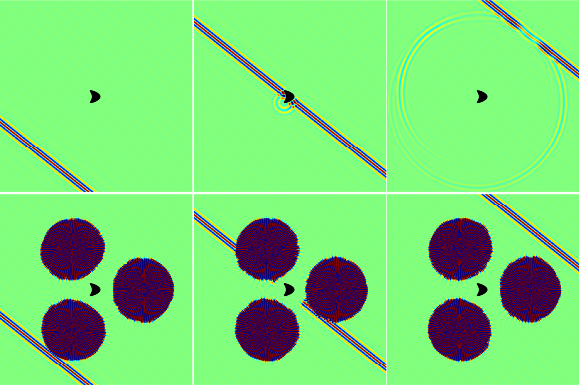
Although our simulations are purely two dimensional, we are confident our method works in three dimensions as well. One disadvantage of our method is that one needs to know the incoming wave in advance. This could be achieved by having outpost sensors that relay this information to the devices. Therefore information from the sensors has to travel faster to the devices than the incoming wave. This is achievable if we are working with water waves or earthquakes. However for electromagnetic waves, the information cannot travel faster than light, and so our scheme would not be feasible, unless something is assumed about the incoming wave (for example that the radar pulse is periodic and that we have a couple of periods to become invisible).
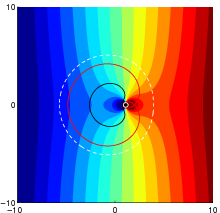
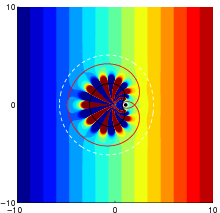
We first proposed this method for “waves” with a very small frequency, which satisfy the so called Laplace equation. In this case only one device is needed. On the simulations on the left the device would be inside the “black bean” and the region to be cloaked the small white circle to the right of the bean. The field lines of the probing field should be vertical. The presence of a small scatterer inside the white circle (left) deforms the field lines and means one can detect the presence of the scatterer. Now when the cloaking device is active (right), the field lines are for all practical purposes vertical, and so the object is invisible and cannot be detected. (The images for Laplace equation come from the PRL article below and are copyright APS)
This is work in collaboration with Graeme W. Milton and Daniel Onofrei, both from the University of Utah. Our method of cloaking for waves is discussed in more detail in the following articles (open access)
- F. Guevara Vasquez, G. W. Milton, D. Onofrei, Active exterior cloaking for the 2D Laplace and Helmholtz Equations, Physical Review Letters, 103 (2009), 073901. DOI: 10.1103/PhysRevLett.103.073901, arXiv: arXiv:0906.1544 [math-ph]
- F. Guevara Vasquez, G. W. Milton, D. Onofrei, Broadband exterior cloaking, Optics Express, 17 (2009), 14800-14805.
DOI: 10.1364/OE.17.014800, arXiv: arXiv:0907.0263 [math-ph]
Matlab demos for cloaking
Here are some interactive demos that I use in my talks about cloaking. They under the BSD License. Please credit the author if you use them in public. The demos require Matlab and each consists of .m and a .fig file. Both files need to be in the same directory for the demos to work properly.
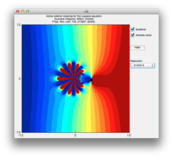
Active exterior cloaking for the Laplace equation in 2D
Roughly speaking, this corresponds to a situation where two infinite plates create a uniform voltage gradient in between (vertical isopotential lines). In the absence of a cloaking device a scatterer can be easily detected because isopotential lines are not vertical anymore. If the cloaking device is activated, the scatterer can be moved to the cloaked region. Once it is there, the scatterer is much harder to detect since the isopotential lines are vertical sufficiently far away from the cloaking device.
Files: clk.fig and clk.m
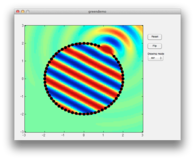
Cloaking using the Green’s identities for the Helmholtz equation in 2D
Here we use sources (monopoles and dipoles) that have been precomputed to reproduce a plane wave inside a circular region (you activate all the sources using the OR drawing mode and dragging the cursor along the circular region boundary, the fields will be automatically updated). This can be considered a cloak because these sources can be used to cancel out the field inside the circular region without generating any field (Miller 2006). If any of the sources are removed then the cloak sends out waves, which is (up to a sign) the field that the source emits by itself (you can try this by removing a source using the XOR drawing mode and then using the Flip button. Our approach to cloaking for the Helmholtz equation is to replace parts of the boundary of the cloaked region by a few point-like sources.
Files: greendemo.fig and greendemo.m
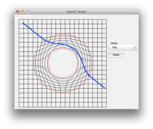
Transformation based cloaking
The main idea here is to generate a medium (annular region) that bends light rays away from the cloaked region (inner circle) in such a way that they come out with the same direction that they entered. This demo has two modes: Transformation mode: allows to adjust the size of the cloaked region. Simply click and drag the inner most circle. Ray mode: alows to draw a ray and calculates how the ray bends as it enters the cloaked region. In this mode press and hold the mouse at the location where the ray starts and release it where the ray ends.
For more information about this cloaking method, please see this nice review article:
A. Greenleaf, Y. Kurylev, M. Lassas, G. Uhlmann, Cloaking Devices, Electromagnetic Wormholes and Transformation Optics, SIAM Review 51 (2009), 3-33. DOI: 10.1137/080716827. Also available from Gunther Uhlmann’s webpage.
Files: transf_demo.fig and transf_demo.m
Here are some slides I used for three 30min workshops I presented to high-school students on “How to become invisible without a cloak” during the Science Day at the U event (Nov 7 2009): sciday.pdf (the videos are available on request).
Electrical impedance tomography with resistor networks
For my thesis work I studied a reconstruction method for the electrical impedance tomograpy (EIT) problem. In this problem the conductivity inside a region is to be recovered from measurements of voltages and currents at the boundary. This is a severely ill-posed problem, meaning small perturbations in the measurements can lead to big reconstruction errors.
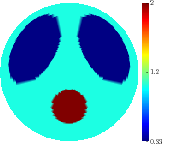
We propose a method to estimate the conductivity from a reduced model of the true problem. This model has deliberately few parameters to cope with the ill-posedness. The parameters in our model are resistors in a network that can, in principle, perfectly reproduce the measurements. The conductivity is recovered by interpreting these resistors as averages of the conductivity in a finite volumes discretization of the problem. The choice of the grid in this finite volumes discretization is crucial and we take it to be the grid that would reproduce the measurements exactly if the conductivity was constant.
We illustrate this process with a conductivity phantom that is commonly used in EIT as a crude model of a human chest (left). A synthetic data set is generated with this conductivity and 1% noise is added to it.
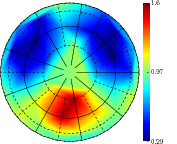
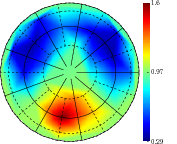
A first and fast estimate of the conductivity is given by our reduced model approach (left). Here the resistor network that is used for the reconstruction appears in solid line and the cell boundaries of the finite volumes discretization in dashed lines. The magnitudes the reconstructed values are not very close to the true values. This is because we are not recovering the conductivity but certain averages of the conductivity on the grid cells. Since we know the conductivity, we can compute them and compare our reconstructions to these averages (right).
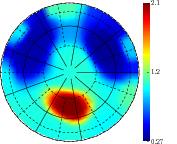
The reconstruction can be further enhanced by using a priori information (left). In this case since the conductivity is piecewise constant we used a total variation regularization.
This is work in collaboration with Liliana Borcea (Rice University) and Vladimir Druskin (Schlumberger Doll research). The figures come from the article below and are copyright IOP publishing. For a full discussion of this work, please see the article:
- L. Borcea, V. Druskin, F. Guevara Vasquez, Electrical Impedance Tomography with Resistor Networks, Inverse Problems, 24 (2008), issue 4, 035013. (on the Inverse Problems Editorial Board Highlights for 2008). DOI: 10.1088/0266-5611/24/3/035013
Research interests
- Cloaking
- Aquifer imaging
- Imaging with waves, selective focussing
- Parameterization of inverse Problems
- Electrical Impedance Tomography
- Inverse problems in networks
- Elliptic Partial Differential Equations
- Level-set methods
Career path
A complete resumé is available here: resume.pdf
Current position: Assistant professor at the University of Utah Department of Mathematics.
Previous studies:
2006 PhD Computation and Applied Mathematics from the CAAM department at Rice University (Houston, TX). Thesis title: On the parameterization of ill-posed inverse problems arising from elliptic differential equation. Advisor: Liliana Borcea.
2001 Engineering degree in Applied Mathematics and Computer Science from ENSEEIHT (École Nationale Supérieure d’Électrotechnique, d’Électronique, d’Informatique, d’Hydraulique et des Télécommunications) a french national engineering school located in Toulouse, France.
Previous positions:
2006-2007 Postdoctoral researcher at the Stanford Mathematics Department, working on wave imaging with George Papanicolaou.
2001 Software engineer for the PALM project (an MPI based data assimilation library) at CERFACS (European Center for Advanced Training in Scientific Computing).
2000 Internship in Parallel Algorithms team at CERFACS. Worked on domain decomposition methods for elliptic equations (advisors: Patrick Amestoy, Michel Daydé and Luc Giraud)